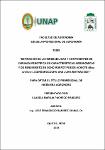| dc.contributor.advisor | Ramírez Chung, José Francisco | |
| dc.contributor.author | Pacheco Panduro, Claudia Marilia | |
| dc.date.accessioned | 2024-01-29T18:46:44Z | |
| dc.date.available | 2024-01-29T18:46:44Z | |
| dc.date.issued | 2023 | |
| dc.identifier.other | 571.8 P12 2023 | |
| dc.identifier.uri | https://hdl.handle.net/20.500.12737/9751 | |
| dc.description.abstract | The work was carried out in the environments of the teaching and research workshop on Amazonian medicinal crops, located in the environments of the Faculty of Agronomy of the UNAP, university city Zungarococha. The work corresponded to the explanatory level. The aim was to generate information on aspects of phenotypic variance components and heritability in the broad sense for, weight of 100 seeds, petal length, fruit length, seeds per fruit and number of stamens per flower studied in eight morphotypes of annatto (Bixa orellana L). The unrestrictedly random experimental design was used, three repetitions and eight experimental stimuli. An experimental unit was one tree and sampling unit was three trees/morphotype. In the weight of 100 seeds in grams, a greater contribution of the environmental component than the genetic effects were found. For petal length, fruit length, number of seeds and number of stamens, the contribution of the genetic component was greater than the environmental one with values of 0.54, 0.11, 0.98, 167.34 and 1.786. The heritability was low for weight of 100 seeds with 45% but for petal length, fruit length, number of seeds and number of stamens the heritability was 58%, 82%, 80% and 87% respectively. It is recommended to make a better discrimination of the additive and dominant effects of the genetic variance by using the intragenerational mating system I of Comstock and Robinson as well as to discriminate from the genetic effects present in the materials studied those related to the interaction effects by repeating the work. in more locations or years, as well as using stratified mass selection as a breeding method for petal, fruit, seed and stamen length to present heritability values and contribution to genetic gain in an acceptable manner. | en_US |
| dc.description.abstract | El trabajo se ejecutó en los ambientes del taller de enseñanza e investigación de cultivos medicinales amazónicos, ubicada de los ambientes de la Facultad de Agronomía de la UNAP, ciudad universitaria Zungarococha. El trabajo correspondió al nivel explicativo. Se buscó generar información en aspectos de componentes de variancia fenotípica y heredabilidad en el sentido amplio para peso de 100 semillas, longitud de pétalo, longitud de fruto, semillas por fruto y número de estambres por flor estudiados en ocho morfotipos de achiote (Bixa orellana L). Se utilizó el diseño experimental irrestrictamente al azar, tres repeticiones y ocho estímulos experimentales. Una unidad experimental fue un árbol y de muestreo fueron tres árboles/morfotipo. En el peso de 100 semillas en gramos se encontró una mayor contribución del componente ambiental que los efectos genéticos. Para longitud de pétalo, de fruto, número de semillas y número de estambres la contribución del componente genético fue mayor que el ambiental con valores de 0.54, 0.11, 0.98, 167.34 y 1,786. La heredabilidad fue baja para peso de 100 semillas con 45% pero para longitud de pétalo, longitud de fruto, número de semillas y número de estambres la heredabilidad fue de 58%, 82%, 80% y 87% respectivamente. Se recomienda realizar una mejor discriminación de los efectos aditivos y dominantes de la variancia genética haciendo uso del sistema de apareamiento intra generacional de Comstock y Robinson así como discriminar de los efectos genéticos presentes en los materiales estudiados aquella relacionadas con los efectos de interacción repitiendo el trabajo en más localidades o años, así como utilizar la selección masal estratificada como método de mejoramiento para longitud de pétalo, de fruto, de semillas y de estambres por presentar valores de heredabilidad y contribución a la ganancia genética de manera aceptable. | es_PE |
| dc.format | application/pdf | es_PE |
| dc.language.iso | spa | es_PE |
| dc.publisher | Universidad Nacional de la Amazonía Peruana | es_PE |
| dc.rights | info:eu-repo/semantics/openAccess | * |
| dc.rights.uri | https://creativecommons.org/licenses/by/4.0/ | * |
| dc.subject | Fenotipos | es_PE |
| dc.subject | Heredabilidad | es_PE |
| dc.subject | Características agronómicas | es_PE |
| dc.subject | Rendimiento | es_PE |
| dc.subject | Achiote | es_PE |
| dc.subject | Bixa orellana | es_PE |
| dc.title | Estimación de la heredabilidad y componentes de varianza fenotípica en características agronómicas y de rendimiento en ocho morfotipos de achiote (Bixa orellana L) Zungarococha. San Juan. Maynas-2021 | es_PE |
| dc.type | info:eu-repo/semantics/bachelorThesis | es_PE |
| thesis.degree.discipline | Agronomía | es_PE |
| thesis.degree.grantor | Universidad Nacional de la Amazonía Peruana. Facultad de Agronomía | es_PE |
| thesis.degree.name | Ingeniero(a) Agrónomo | es_PE |
| dc.subject.ocde | https://purl.org/pe-repo/ocde/ford#4.01.06 | es_PE |
| renati.author.dni | 46038498 | |
| renati.advisor.orcid | https://orcid.org/0000-0002-9952-1169 | |
| renati.advisor.dni | 05286297 | |
| renati.type | https://purl.org/pe-repo/renati/type#tesis | es_PE |
| renati.discipline | 811036 | es_PE |
| renati.level | https://purl.org/pe-repo/renati/level#tituloProfesional | es_PE |
| renati.juror | Urrelo Correa, Juan Imerio | |
| renati.juror | Pinedo Jimenez, Julio | |
| renati.juror | Cubas Encinas, Omar | |
| dc.publisher.country | PE | es_PE |





